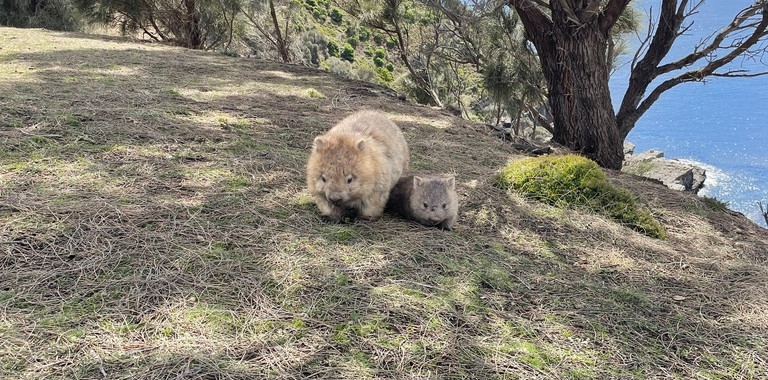Maria Island | A Guide to the Perfect Day Trip
- Lindley Bach
- Oct 11, 2021
- 5 min read

We just got back from a wonderful weekend trip to Maria Island. Maria Island is the coolest island you’ve never heard of!
Although little known, it’s worth a stop. It’s known as Tasmania’s Noah’s ark. The island itself is mostly untouched, as cars aren’t allowed on it.
You can explore convict heritage sites, amazing wildlife, and great outdoor activities like hiking, biking, and camping. But don’t forget to bring food! There are no shops on this little island. And if you miss the 4 PM ferry, you’re sleeping with the wombats!
Since the island is little known, you won’t have to fight lines of people to enjoy the experience. And you’ll be able to have close encounters with wildlife. Getting there on a sunny day was a priority for us, and I do highly recommend going on a nice day.
Here’s my guide to visiting Maria Island, Tasmania. It covers all the bases including things to see, how to get there, how to get around, and what to bring.
Maria Island Logistics
Aussies call it “ma-rye-ah” island, not “ma-ree-ah” island FYI. Some of the highlights include historical sites where convicts were held, wildlife galore, and excellent hiking and biking!
Maria Island is located off the east coast of Tasmania via a 40-minute ferry ride from Triabunna. The ferry dock is a one-hour drive from Hobart or 2.5 hours from Launceston.
The Maria Island ferry ride costs $45AUD per adult. You must also have a valid National Parks pass. Prices vary but start at $12/person/day with discounts for longer durations. We bought the year pass; it pays off if you have two people and visit more than two national parks.
The best time to visit Maria Island is whenever you’re there, but the weather is warmest from December to March. We visited in October, and got to see all the baby spring animals- bonus!
You should plan to at least spend half a day on Maria Island. In a full day, you can see all of the major sights. You can also do an overnight trip for the full-on experience.
Visit the Convict Sites at Darlington
The main convict sites on Maria Island are in the former town of Darlington. Much of the area has been restored to look like the 1890s and if you walk around you can read about the history of each building. When you exit the ferry you’ll walk straight into Darlington.
Enjoy the Wildlife
The wildlife on this island has been one of the highlights of my time in Australia! There are no cars, and no predators, so the native wildlife thrives.
Maria Island has healthy populations of wombats, pademelons, and wallabies. And is probably most well known for its wombats. The island is also home to some threatened populations of native animals.

In the 1960s Forester kangaroo populations were declining on the mainland, so kangaroos were brought to Maria Island. These populations are now doing well. The same thing happened with Cape Barren Geese.
The Tasmanian Devils have also started to decline since the early 2000s and have been released on Maria Island. The hope is to move Devils back to the mainland after a few years when they can survive on their own on Maria Island.
We saw animals all over the island! But the kangaroos happened to all be hanging out by the little airstrip. Keep your eyes peeled! Rasmus spotted the Echidna that we saw, but they are pretty good at blending in.
Check Out the Painted Cliffs
The painted cliffs are a Maria Island icon. The walk is about four kilometers from the boat, and worth the walk. If you go out at the low tide, you’ll be able to see some cool ocean life like urchins, fish, and shells.
Explore the Island by Bike
Unfortunately, I busted my collarbone before our trip, and we couldn’t bike. But we had planned to bike! One of the best ways to explore Maria Island is by bike. You can get around faster so you can travel further and see more of the island. We saw lots of people on rented bikes, and it looked super fun. The roads are well maintained for easy pushbike strolls or off-roading for the more advanced biker.

Go Birdwatching
They say Maria Island is home to all but one of Tasmania’s twelve endemic birds. (That means species that are found only in Tasmania.) We really enjoyed watching the Cape Barren Geese, to me, they looked like dinosaur birds. This is the spot for bird watchers!
Walk the Fossil Cliffs Loop
Rasmus and I enjoyed this laid-back loop. It features some old settlements around the island, as well as tons of wildlife. The Fossil Cliffs themselves are OLD, like 300 million years old. And if you look closely you can spot fossils in the side of the rock.
It was on this walk that we found a lot of baby wombats! If I had more time I would have probably liked to have hiked to Bishop and Clerk Peaks and Mount Maria - both good bets if you’re staying overnight!
Go to the Beach
Some of the most beautiful beaches I’ve ever seen are in Tasmania. They just seem crystal clear and boast colors that make you feel like you’re seeing things!
Maria Island Day Trip Packing List
Here’s a list of things to bring to Maria Island:
Snacks and lunch
Water bottle (there is drinking water at Darlington campsite so you can refill your bottle)
Camera
Hiking boots or shoes
Sun hat and sunscreen
Rain jacket and warm clothing in case the weather turns bad
Bathing suit and towel
Backpack
Trash bags – there are no bins on the island and you need to take all rubbish out with you
Bike and helmet (optional)
There are absolutely no shops or restaurants on Maria Island so you will need to bring everything you think you’ll need with you.
Maria Island History
According to the official Maria Island website,
“The original inhabitants of Maria Island were the Puthikwilayti people – aboriginal people, and members of the Oyster Bay tribe. For more than 40,000 years the Puthikwilayti people were custodians of the land and surrounding waters.
European explorers first caught sight of the island in 1642 but didn’t come ashore until 1789. John Henry Cox and Lieutenant George Mortimer (English explorers) were the first Europeans to step foot on the island and document the presence of Aborigines.
In 1825, fifty convicts were brought to the island by English soldiers. The settlement of Darlington held convicts who had reoffended and were sentenced to hard labor.
Due mainly to frequent escape attempts, the settlement closed in 1832, only to re-open again some 10 years later. The second convict era lasted for eight years (1842 – 1850) with a focus on agriculture, industry, and training. Once again convict rebellion was a factor that led to its closure.
In the 1880s Diego Bernacchi, an Italian businessman leased the land with ambitious plans for agriculture, industry, and tourism (wine and concrete!) Farming and fishing ventures followed the Italian’s failed business pursuits, and eventually, the island was declared a National Park in 1972.” - https://encountermaria.com.au/history/

Maria Island FAQs
How do you get to Maria Island?
To get to Maria Island you take a ferry from Triabunna, located off the Tasman Highway (A3). The ferry service runs between Triabunna and Darlington and takes around 40 minutes.
How long does it take to get to Maria Island from Hobart?
Maria Island is accessed from Triabunna, which is about an hour and fifteen minutes from Hobart.
How much does it cost to go to Maria Island?
In 2021 the ferry is $45 AUD for adults and $28 per child.
Is there drinking water on Maria Island?
Yes, in from Mess Hall in Darlington.
How long does it take to walk around Maria Island?
You could spend anywhere from two hours to two days walking around the island, but you can hit the main spots within a few hours.
You may want to save this image for later:

























































































